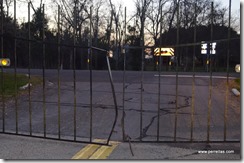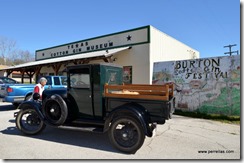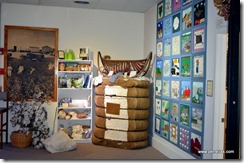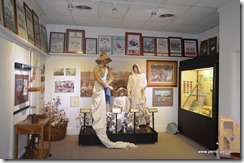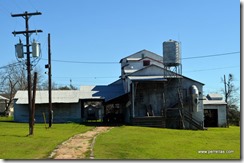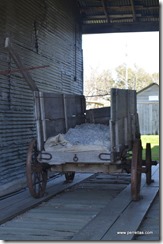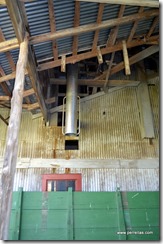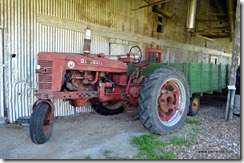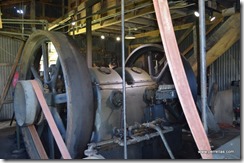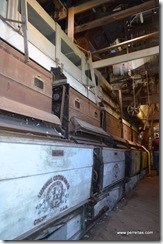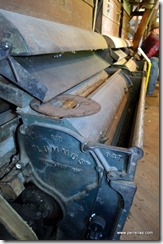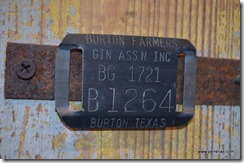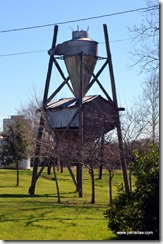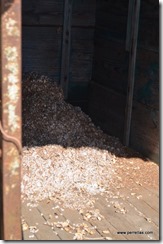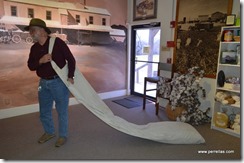This past month our adventures have been seriously curtailed. Volunteering twice a week, hastily up and back for visits to family in Conroe in-between performing necessary daily chores and fixing the inevitable “It’s Always Something” that breaks around LilyPad on our days off. It is amazing how many things pop up to keep one from venturing outside the immediate Navasota area. We squeezed in just enough detours in the “same old, same old” mix to keep ourselves, what some might consider, sane.
Weather, warm or cold, rain or shine, has not kept groups and families from coming out to visit Washington on the Brazos State Historical Park and all this beautiful 300 acres has to offer. Living in the parking lot avails us the view of visitors going to and fro across the front of LilyPads nose. The influx of people cause Chrissie to growl more often at our back window and this morning she broke out into a donkey braying hee-haw sound after growling didn’t produce the anticipated results. Not one to give up, she is still as determined to get to the other field as the rangers are to keep her out.
Dinner out tonight at our favorite hole in the wall Mexican eatery, Eric’s in Navasota. Returning to Washington on the Brazos and exiting the car to close the gate behind us, realized that it had been badly damaged on one side and was unable to shut properly. Looking as though someone had snagged it and pulled the main bar of the gate out, bowing it substantially. I was concerned as that was not its condition when we closed up the previous night. This is a steel gate and would be difficult to damage by accident.
We slowly and carefully drove through the park with high beams and our 300 lumen flashlight, checking each and every corner of the park. We are alone again, one volunteer couple gone, unable to complete their season due to a family emergency and the other gone for the week to take care of personal business. Uncomfortable feeling, especially when there has been a rash of robberies in our neighborhood, surprising considering the town of Washington is a one blink town. As sunset passed into night, I slept uneasily with one eye open.
Next night, after escorting a family out of the park after dark, I stayed awake catching up on Facebook family happenings and emails. John was snoring. Sound on the computer was off. 7 knocks, spaced a few seconds apart, on the outside of the rig, starting from the back and working their way to the front. I walked to the front and listened, hearing muffled sounds. Hairs on the back of my neck prickled and I made a dash to the back to wake John. Explained the situation, he said “call 911 and get the bear spray”. We turned on the outside lights and moved our spot light around in front. Not a soul in sight at the front of the rig. All noises stopped as we stood still in our PJ’s waiting for the sheriff to arrive. To our relief, two pulled up with bright headlights and spot lights surveying the area. They checked around the outside and, for the very first time in our years of travel, told us we would be wise to get a gun. Another uncomfortable feeling. Never found out what made the noise although they found three neighboring escaped horses wandering around the farm. Not unless those horses sprouted knuckles did I believe they were the cause of the knocks on the outside of our rig.
Next morning I considered what other protection might make an agreeable alternative. Looking up bear spray, I realized that if I shot it off inside LilyPad I would not only shock the aggressor, but it would completely shut down my lungs! The spray is absolutely not to be used indoors and I imagine spraying inside our box on wheels would compound the negative effects. Hmmm, don’t want a gun, can’t use bear spray…maybe I’ll look into Tasers.
After several consecutive days of rain and cold weather and the possibility of a sunny day in the near future, we planned a road trip to Burton TX, home of the oldest working cotton gin in the country, very much hoping to coincide our visit with a warm sunny day.
Arriving in Burton, another tiny “don’t blink” town just past Brenham, we arrived at the Gin just in time to see a Burton antique car collector pulling into the parking lot to avail her car to a local political hopeful for a photo op.
Starting with a wander through the museum, the tour is approximately 1-1/2 hours long and very entertaining.
The tour was led by a volunteer who’s family owned cotton fields that used the gin so his experiences with the gin and growing cotton were first hand. In 1914 this two story corrugated metal-clad building was constructed without blueprints by German descendent farmers.
Wagons were pulled up to the “sucker” and the cotton was sucked up into the gin. Tractors were used by the gin after the team was unhooked.
This cotton gin is the earliest known survivor of an integrated cotton ginning system that was used to process cotton, from wagon to bail, in continuous operation. The capacity was 7 bales per hour. The bails, by law, had to be a certain size but no certain weight. The goal was to have the bails weigh in at 500 pounds or more or the buyers paid less per bail.
The gin’s machinery was steam powered until 1925 when an oil engine was installed. This 125 HP Bessemer Oil Engine, which ran continuously from 1925 until 1974, still runs once a year to bail local cotton for the Burton Cotton Festival. The gin became a Texas historical landmark in 1988.
Over 60 years of operations, the Burton Farmers Gin maintained an excellent safety record, never having a serious accident with much credit for this fact given to the excellent group of managers.
The battery stands for the gin are known as the “Five-Eighty” meaning there are five Lummus Gin Stands with eighty blades each. The blades are responsible for pulling the cotton lint from the seeds and blowing it on down the line to be bailed.
The bailing turntable had two presses mounted on it allowing one bail to be strapped and pushed out while another was being pressed, tagged and sent out of the gin. 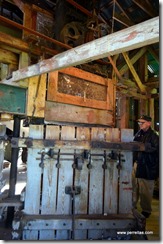
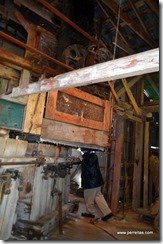
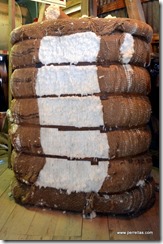
Pressed, tagged, banded, weighed and pushed down the ramp, the cotton was either taken away by the owner, stored at the gin warehouse for sale or purchased by a buyer direct from the gin.
The metal tags were an important and necessary part of the ginning process. From this tag, a buyer could tell where the cotton was grown, which farmer grew the cotton and what crop he was buying. If he liked the cotton, he looked for this tag at sales. If he wanted to stay clear, the tag would give him all the information he needed.
The remaining “trash” was blown into a holding container. If the owner wanted it back, he could pull his wagon up under, dump the contents into the wagon and be on his way, all within a few minutes from the time he pulled up to the cotton sucker.
When the gin first operated, the trash was given back to the farmer to plow into their fields or to use as feed for his cattle. Later, when seed pressing became available, the seeds were sold for oil and the farmers took in a few extra cents for their wagon load.
After the tour we saw a movie showing the Burton gin in action and the tour guide gave us a mini gin demonstration, complete with offering ginned seeds for planting and instructions on how to grow cotton.
On our way out, John tried on a cotton picking bag. The bags held 200-250 pounds of cotton and were dragged through the fields until they were full before dumping them into the wagons. Another way of life I would not have enjoyed.
Our trip back was uneventful save for the awesome sun setting in the distance as we drove the rolling ribbons of asphalt back to the Farm.

